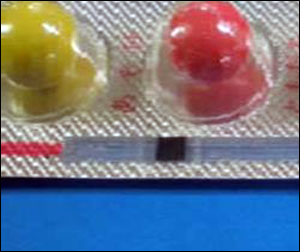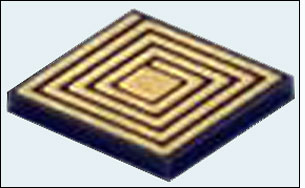Hitachi Chemical is marketing an EPC Gen 2 passive ultrahigh-frequency (UHF) RFID tag that is one of the smallest tags on the market, measuring just 2.5 millimeters (0.098 inch) square and 0.3 millimeter (0.012 inch) thick. Consisting of an Impinj Monza 5 chip and an antenna embedded in epoxy resin, the Ultra-Small Package tag is designed to be durable enough that it could be applied via injection molding or incorporated into printed circuit boards. This means the tag could be built into a circuit board or a semiconductor’s packaging, and sustain the temperatures typically used during the manufacturing processes—as high as 260 degrees Celsius (500 degrees Fahrenheit).
What especially differentiates the tag, however, is its ability to extend its read range. Due to the antenna’s small size, the tag can be interrogated only in the near field—approximately 10 millimeters (0.39 inch). However, the company reports, the read range could be extended up to 4 meters (13.1 feet) via a booster antenna that could be designed specifically for the tag. Alternatively, the range could be extended simply by mounting the tag adjacent to a metallic component of the object on which the tag was mounted.
The tag was commercially launched in January 2012, says Akira Nagase, a senior manager with Hitachi Chemical’s marketing department for RFID projects, and is available worldwide. The company began providing RFID technology in the form of high-frequency (HF) tags about 15 years ago. In 2004, it began producing EPC UHF tags, which it currently manufactures using Monza 5 chips. Around three years ago, the firm started working to create the Ultra-Small Package tag. Hitachi Chemical codeveloped the Ultra-Small Package tag with its parent company, Hitachi, by drawing from the semiconductor packaging technologies of the Hitachi group.
In developing the tag, Nagase says, the company’s goal was “not to make just another inlay. We wanted to differentiate [our product] from other inlays.” Its size and durability—it can operate at temperatures of -40 degrees to +85 degrees Celsius (-40 degrees to +185 degrees Fahrenheit—make it unique, he says, as does the ability of the tag’s built-in antenna to capacitively couple with a booster antenna (or other metallic object), thereby extending read range to 4 or 5 meters (13.1 feet to 16.4 feet).Hitachi is currently in the process of seeking partners that could make such a booster antenna for this inlay. However, the company reports, practically any other type of metal surface could be utilized to boost the tag’s signal, with the metal surface serving as a conductor of the RF signal to lengthen read range. The Ultra-Small Package tag could, for example, be placed within the metal foil of a wine bottle’s label, thereby extending its read range considerably without requiring an additional antenna.

Similarly, if the tag were attached to the foil wrap of a medicine package, it could be read by a UHF far-field reader. Nagase says he also envisions the tag being used within the health-care sector, in order to track such small items as medical equipment or test tubes. Another potential application would be item-level apparel tracking by retailers and clothing suppliers, with the tag embedded in a textile label sewn into a garment, and metallic yarn stitched into the label to serve as a booster antenna.
The tags cost approximately 30 cents each in orders of one million, Nagase says, though he expects that the price will drop as more high-volume orders are received.
According to Nagase, the Ultra-Small Package tag was launched this year as one of three new UHF RFID products, including a weldable metallic tag and a document control tag—though the latter two models are not being sold within the United States at this time, but rather are focused in the Asian market.


